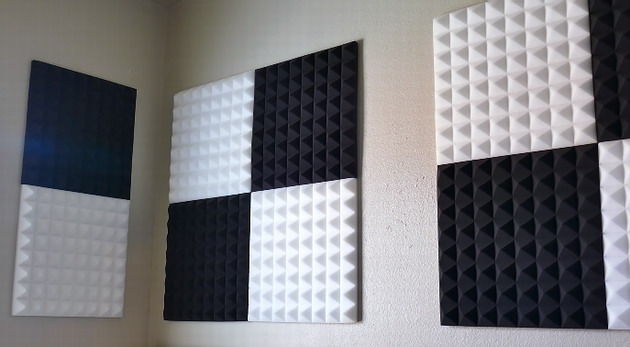Acoustic Foams: Soundproofing and Thermal Insulation in One Solution
In this blog, we’ll explore what acoustic foams are, how they work, how they’re manufactured, and review some of the best commercial products available in the US and Canada.


When building or renovating a space—whether it’s a music studio, office, theater, or industrial facility—noise control and energy efficiency are critical. That’s where acoustic foam comes in. Known primarily for sound absorption, acoustic foams also provide valuable thermal insulation, making them a dual-purpose material for both comfort and performance.
In this blog, we’ll explore what acoustic foams are, how they work, how they’re manufactured, and review some of the best commercial products available in the US and Canada.
What Is Acoustic Foam?
Acoustic foam is a lightweight, open-cell polyurethane or melamine-based material specifically designed to absorb sound waves and reduce noise levels in enclosed spaces. It works by reducing reverberation and echo, and is used to improve sound clarity and acoustic comfort.
But beyond its acoustic properties, many types of acoustic foam also offer thermal insulation, helping to maintain indoor temperatures and reduce HVAC energy costs.
How Acoustic Foam Works
Acoustic foams are effective at absorbing mid-to-high frequency sound waves. The porous, open-cell structure causes sound energy to enter the foam and become trapped in the cells, where it is dissipated as low-level heat through friction.
Acoustic Benefits:
Reduces echo and flutter
Improves voice clarity
Decreases overall noise level
Prevents sound transmission between rooms (when used with dense barriers)
Thermal Benefits:
Acts as a thermal insulator
Reduces heat transfer through walls or ceilings
Enhances energy efficiency in heated or cooled rooms
Where Acoustic Foam Is Used
Home studios and music production rooms
Home theaters and gaming rooms
Offices and call centers
Gymnasiums and auditoriums
Industrial machinery enclosures
HVAC systems and duct liners
How Is Acoustic Foam Made?
Acoustic foam is typically made using open-cell polyurethane or melamine foam. Here's a simplified overview of the process:
1. Foam Formation
Polyurethane is created by reacting polyols and isocyanates in the presence of catalysts, surfactants, and blowing agents (typically water or chemical gases). For acoustic foams, the formula is designed to create large, open pores for better sound absorption.
2. Curing and Cutting
After rising and curing, the foam block is cut into panels or shapes like wedges, pyramids, or convoluted (egg crate) forms. These geometries increase surface area and enhance sound wave disruption.
3. Fire Retardant and Surface Treatments
To meet building codes, acoustic foam is often treated with fire retardants or made from inherently flame-resistant materials such as melamine resin foams.
Types of Acoustic Foam
Foam TypeKey FeaturesBest ForPolyurethane FoamBudget-friendly, good acoustic absorptionHome studios, officesMelamine FoamFire-resistant, better thermal insulationCommercial and industrial useConvoluted Foam (Egg Crate)Low cost, large surface areaTemporary soundproofingWedge/Pyramid PanelsPrecise control over sound wavesProfessional recording studios
Top Commercial Acoustic Foam Products in the US and Canada
Below are some of the most popular and top-rated acoustic foam products available online or through building suppliers:
1. Auralex Acoustics Studiofoam Wedges
Made in the USA
NRC rating of 0.80+
High-density polyurethane
Ideal for music studios and vocal booths
Where to Buy: Amazon, Sweetwater, B&H
Typical Price: $100–$200 per 12-pack (2" thick panels)
2. Soundproof Cow Acoustic Panels
Customizable shapes and colors
Class A fire-rated melamine foam
Offers both sound absorption and thermal insulation
Where to Buy: SoundproofCow.com
Typical Price: $30–$70 per panel (2"–4" thick)
3. Foamily Pyramid Acoustic Panels
Budget-friendly option for small rooms
Made of high-density polyurethane
Easy to install with adhesive spray or double-sided tape
Where to Buy: Amazon, Walmart Canada
Typical Price: $25–$40 per 12-pack
4. Owens Corning 703 Fiberglass Panels (with fabric wrap)
Not foam, but often used similarly
High NRC rating and excellent thermal insulation
Common in professional environments
Where to Buy: Acoustimac, ATS Acoustics
Typical Price: $80–$150 per 6-pack (2" thick)
5. Sonex by Pinta Acoustic (Melamine Panels)
Lightweight, flame-resistant, and high-performance
Used in industrial, office, and medical settings
Excellent for both sound and thermal control
Where to Buy: AcousticalSolutions.com
Typical Price: Varies by thickness and size
Installation Tips for Acoustic Foam
Use adhesive spray or foam-safe caulk for easy mounting
Cover first reflection points on walls and ceiling for maximum sound improvement
For combined soundproofing + insulation, pair acoustic foam with:
Mass loaded vinyl (MLV)
Resilient channels
Rigid insulation boards (e.g., Rockwool)
Thermal Insulation Performance
Acoustic foam is not a substitute for dedicated insulation, but it adds thermal resistance when used with other insulating layers. Its R-value is typically low (around R-1.5 to R-3 per inch), but when applied across large areas, it contributes to:
Reduced HVAC cycling
Temperature stabilization in rooms
Improved building envelope performance
Melamine foams perform slightly better in this category than polyurethane, especially in commercial and industrial spaces.
Is Acoustic Foam Right for You?
Choose acoustic foam if you:
Want to improve room acoustics, reduce echo, or control noise
Need lightweight, easy-to-install panels
Want moderate thermal insulation as a secondary benefit
Are building a recording studio, quiet office, or media room
For full soundproofing (blocking noise from leaving or entering), combine acoustic foam with dense materials and insulation.
Acoustic foam panels are an excellent investment for sound absorption and thermal efficiency, especially in environments where noise control and energy savings go hand in hand. Whether you're building a home recording studio in Toronto, a podcast room in Los Angeles, or an office in Vancouver, acoustic foam can improve comfort, reduce noise complaints, and enhance performance.
When selecting a product, look for certified fire ratings, reliable NRC values, and appropriate geometry for your application. Brands like Auralex, Soundproof Cow, and Sonex offer professional results for both residential and commercial installations.
